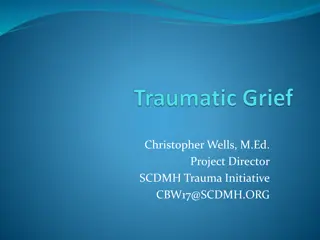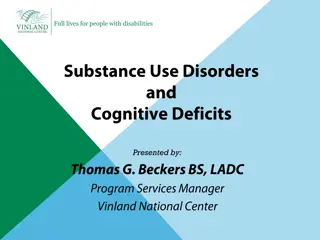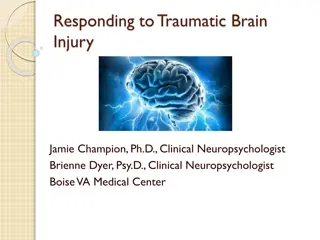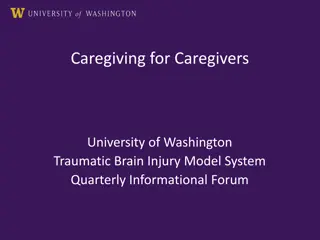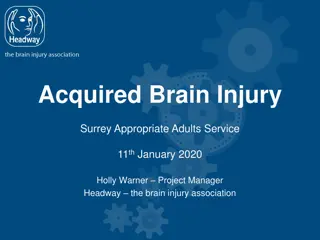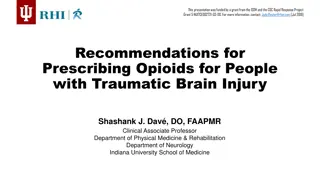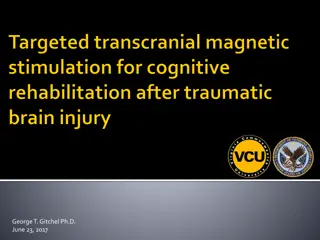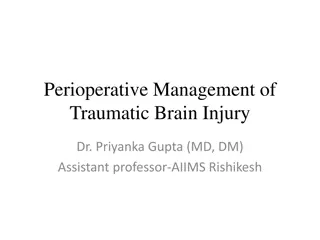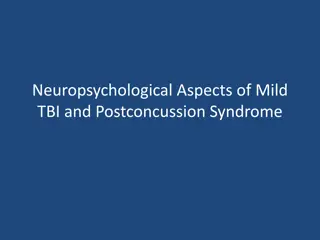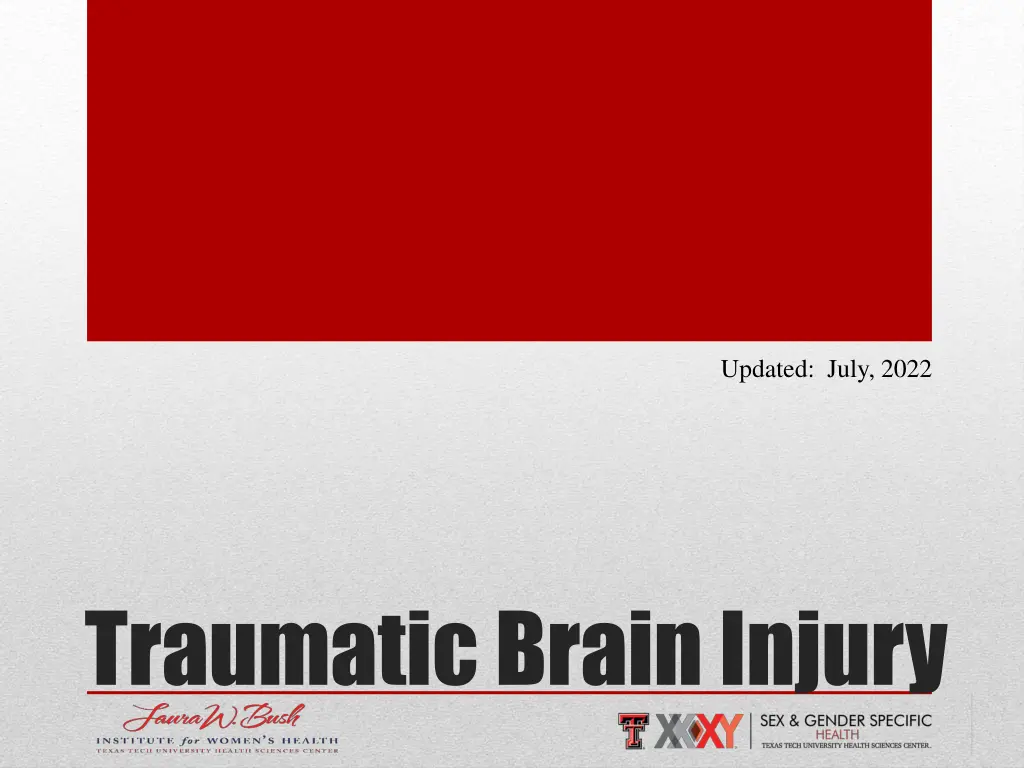
Traumatic Brain Injury (TBI) Overview and Information
Learn about Traumatic Brain Injury (TBI), its various forms, symptoms, diagnosis, and resources provided by organizations like the American Association of Neurological Surgeons and the CDC. Understand the difference between sex and gender and explore coding guidance and incidence statistics related to TBI.
Download Presentation

Please find below an Image/Link to download the presentation.
The content on the website is provided AS IS for your information and personal use only. It may not be sold, licensed, or shared on other websites without obtaining consent from the author. If you encounter any issues during the download, it is possible that the publisher has removed the file from their server.
You are allowed to download the files provided on this website for personal or commercial use, subject to the condition that they are used lawfully. All files are the property of their respective owners.
The content on the website is provided AS IS for your information and personal use only. It may not be sold, licensed, or shared on other websites without obtaining consent from the author.
E N D
Presentation Transcript
Updated: July, 2022 Traumatic Brain Injury
Overview Traumatic Brain Injury
What is it and what else is it called? Traumatic Brain Injury2 An external force that causes severe damage to the brain1,2 Traumatic Brain Injury, or TBI, Concussion, Head Injury, Shaken Baby Syndrome, etc.1 Can be mild to moderate, acute, long-term, and or life threatening1,2 Sex vs. Gender Definition of Sex Scientifically sex may be defined as the biological differences between male and female, including genetic, hormonal and physiological differences. Definition of Gender Gender is thought of as a social construct based upon interpersonal roles or personal identification and is often not concordant with biological sex. Definition
Clinical Presentation Traumatic Brain Injury
American Association of Neurological Surgeons TBI Symptoms Loss of or decreased consciousness Loss of memory for events before or after the event (amnesia) Focal neurological deficits such as muscle weakness, loss of vision, change in speech Alteration in mental state such as disorientation, slow thinking, or difficulty concentrating Clinical Presentation
Diagnosis Traumatic Brain Injury
Coding Guidance for Traumatic Brain Injury As classified by the ICD-10 Codes Acute Injury Late Effect or Sequela Symptoms Involving Emotional State Symptoms Involving Cognitive Function and Awareness Physical Effects of TBI Diagnosis
CDCs Guidelines For Healthcare Providers Links Pediatric Guideline on Mild Traumatic Brain Injury Adult Guideline on Mild Traumatic Brain Injury Diagnosis
Incidence Traumatic Brain Injury
Traumatic Brain Injury (TBI) State Partnership Grant Program1 According to the National Institute on Disability, Independent Living, 1.56 million traumatic brain injuries are reported each year. AANS Traumatic Brain Injury2 According to the American Association of Neurological Surgeons, based on CDC reports, 2.87 million cases of TBI occurred in the U.S. in 2014. Incidence
Emergency Department Visits Per Year Per CDC Rate Differences
Mortality Rate Per Year Per CDC Rate Differences
Prevalence Traumatic Brain Injury
More Work Needed in This Area Prevalence
Risk Factors Traumatic Brain Injury
Societal/Environmental Gender Differences in Adult Traumatic Brain Injury1 Men are at increased risk for TBI due to injury-prone work or dangerous behavior. Skull fracture, AEDH, DAI, TICH, and CSDH are higher in men, and concussion, ASDH, and TSAH are higher in women. Men had a higher proportion of motorcycle, sport, or violent related causes of TBI, while women experienced higher rates of pedestrian or passenger and slip and fall causes of TBI. Risk Factors
Societal/Environmental Gender Differences in Adult Traumatic Brain Injury2 CDC Surveillance Report (2016-2017)2 Men had significantly higher rates for major unintentional and intentional causes of TBI related hospitalization, such as violent injury. Men and women risk factors for TBI closely resemble those of the 2020 research done in Korea.1,2 Other Research Results Research studies have found in sports with similar rules between females and males, in particular soccer, basketball, and baseball/softball, the rates of concussion are higher in women in several sports.3 Risk Factors
Societal/Environmental Sex Differences in Adult Traumatic Brain Injury Related Deaths1 CDC Surveillance Report (2018-2019)1 Among principal mechanisms of injury (MOIs) examined that contributed to TBI-related deaths, males had higher average annual age-adjusted rates for all MOIs when compared with females: Unintentional motor vehicle crashes (an average rate of 4.6 per 100,000 population compared to 1.7 per 100,000 population) Unintentional falls (an average rate of 6.3 compared to 3.2 per 100,000 population) Suicide (an average rate of 13.0 compared to 1.9 per 100,000 population) Homicide (an average rate of 2.5 compared to 1.0 per 100,000 population). Risk Factors
AGE Gender Differences in Adult Traumatic Brain Injury1 Women have a slightly higher incidence of mild TBI than men, due to more falls after the age of 75. CDC Surveillance Report (2016-2017)2 Unintentional falls were the leading cause of injury for TBI- related hospitalizations, and half of these were comprised of ages 75. Ages 75 had the highest hospitalization and mortality rate for TBI s. Risk Factors
AGE Gender Differences in Personal and Situational Risk Factors for Traumatic Brain Injury Among Older Adults3 Indoor falls appear to be more frequent for men, and outdoor falls are more frequent for women. 60 years old men appear to have a higher risk for falls from excessive alcohol consumption, while women have a higher risk due to Parkinson s Disease symptoms. Risk Factors
AGE CDC Surveillance Report (2018-2019)1 TBI related deaths by age group and mechanism of injury Unintentional Motor Vehicle Traffic Crash Unintentionally Struck by or Against an Object Other or Unspecified Unintentional Injury NO. AGE Unintentional Falls Suicide Homicide Other** RATE (95% CI) RATE (95% CI) RATE (95% CI) RATE (95% CI) RATE (95% CI) RATE (95% CI) RATE (95% CI) NO. NO. NO. NO. NO. NO. Birth-17 755 Birth-4 166 5-9 135 10-14 139 0.1 (0.1-0.1) 0.2 (0.2-0.2) 1.0 (1.0-1.1) 0.8 (0.8-0.9) 0.7 (0.6-0.7) 0.7 (0.6-0.7) 37 17 0.1 (0.0-0.1) 0.1 (0.1-0.1) 28 12 0.0 (0.0-0.0) 0.1 (0.0-0.1) 258 111 37 50 0.4 (0.3-0.4) 0.6 (0.5-0.6) 0.2 (0.1-0.2) 0.2 (0.2-0.3) 183 662 292 64 85 0.9 (0.9-1.0) 1.5 (1.4-1.6) 0.3 (0.3-0.4) 0.4 (0.3-0.5) 75 39 0.1 (0.0-0.1) 0.9 (0.8-1.0) 12 15-24 1,996 0.3 (0.2-0.3) 4.7 (4.5-4.8) 88 0.2 (0.2-0.2) 17 0.0 (0.0-0.1) 270 0.6 (0.6-0.7) 2,784 6.5 (6.3-6.7) 1,290 3.0 (2.9-3.1) 108 25-34 1,978 0.3 (0.3-0.4) 4.3 (4.2-4.5) 185 0.4 (0.4-0.4) 39 0.1 (0.1-0.1) 346 0.8 (0.7-0.8) 3,288 7.2 (7.0-7.4) 1,330 2.9 (2.8-3.0) 149 35-44 1,390 0.3 (0.3-0.3) 3.4 (3.2-3.5) 329 0.8 (0.7-0.9) 38 0.1 (0.1-0.1) 334 0.8 (0.7-0.9) 2,933 7.1 (6.9-7.3) 925 2.2 (2.1-2.3) 128 45-54 1,396 0.3 (0.3-0.4) 3.4 (3.3-3.5) 741 1.8 (1.7-1.9) 49 0.1 (0.1-0.1) 482 1.2 (1.1-1.2) 3,219 7.8 (7.6-8.0) 635 1.5 (1.5-1.6) 136 55-64 1,370 0.3 (0.3-0.4) 3.2 (3.1-3.4) 1,706 4.0 (3.9-4.2) 59 0.1 (0.1-0.2) 667 1.6 (1.5-1.7) 3,687 8.7 (8.5-8.9) 529 1.2 (1.2-1.3) 137 65-74 884 0.2 (0.2-0.3) 2.9 (2.7-3.0) 2,945 9.5 (9.3-9.8) 51 0.2 (0.1-0.2) 583 1.9 (1.8-2.0) 2,688 8.7 (8.4-8.9) 283 0.9 (0.8-1.0) 76 75+ 838 0.3 (0.3-0.4) 54.3 (53.6- 55.0) 3.8 (3.6-3.9) 12,076 50 0.2 (0.2-0.3) 1,043 4.7 (4.5-4.9) 2,705 12.2 (11.8-12.5) 171 0.8 (0.7-0.9) 71 Total 10,291 3.1 (3.1-3.2) 18,098 5.5 (5.5-5.6) 329 0.1 (0.1-0.1) 3,920 1.2 (1.2-1.2) 21,486 7.5 (7.4 - 7.5) 5,603 1.7 (1.7-1.7) 863 0.3 (0.3-0.3) Risk Factors
Anatomy Traumatic Brain Injury
2013 Meta-Analysis of Sex Differences in Human Brain Structure1 There is significant literature showing increased brain volume and tissue in men. Larger areas in men are found mostly in bilateral limbic areas and left posterior cingulate gyrus, whereas higher densities are mostly limited to the left side of the limbic system. Larger volumes found in women consist of areas in the right hemisphere related to language, in addition to several limbic structures such as the right insular cortex and anterior cingulate gyrus. Anatomy Pre TBI
2007 Literature review - Evolving Knowledge of Sex Differences in Brain Structure, Function and Chemistry2 After controlling for increased volume, more grey matter was seen in women, with men having more white matter. Men have a larger amygdala and hypothalamus, while women have a larger caudate and hippocampus - may be related to the distribution of estrogen and androgen receptors. Anatomy Pre TBI
Regional Vulnerability after Traumatic Brain Injury: Sex Differences in Mice That Overexpress Human Copper, Zinc Superoxide Dismutase1 Tg-M that overexpressed CuZn SOD had reduced lesion volume compared to nTg-M after an applied craniotomy. Tg-F that overexpressed CuZn SOD had positive neuronal protection that was not seen in the males such as in the hippocampal CA3 and LD. Study did not replicate previous findings on estrogenic protection in specific areas already studied. Anatomy Post TBI
Physiology Traumatic Brain Injury
Evolving Knowledge of Sex Differences in Brain Structure, Function, and Chemistry1 Men have a larger amygdala and hypothalamus, while women have a larger caudate and hippocampus, which may be related to the distribution of estrogen and androgen receptors. The differences also include Dopamine, Serotonin, and GABA systems with higher numbers attributed to women. Physiology Pre TBI
Possible Connection of Developing Hypopituitarism After TBI - Hormonal Side Effects due to Total Empty Sella - Females at 3-fold Risk for Total Empty Sella1 59% and 8% GH/IGF-I deficiency) 47% and 4% (TSH/FT4 deficiency) 15% and 4% (ACTH/cortisol deficiency) 55.9% and 10.6%% (gonadotropin/testosterone or estrogen deficiency) Physiology Post TBI I
Protein Carbonylation After Traumatic Brain Injury: Cell Specificity, Regional Susceptibility, and Sex Differences1 Protein carbonylation by astrocytes was found to be similar in affect at the site of Controlled Cortical Impact. Males showed greater protein carbonylation in cells further along the brain structure. There may be estrogenic and regional effects controlling for differences found. Physiology Post TBI II
Prognosis Traumatic Brain Injury
Cognitive Recovery Gender Differences in Agitation After Traumatic Brain Injury1 Post Traumatic Agitation Experienced by 50% of patients with TBI in rehabilitative services, leading to increased stays No differences observed in recovery rates that recommend differing pharmacotherapeutic treatment based on sex Gender Differences in Executive Functions Following Traumatic Brain Injury2 The Wisconsin Card Sort Test (WCST), used among patients in acute rehabilitative care, shows better outcome for women in executive functioning. Prognosis/Acute
Gender Differences in Awareness and Outcomes During Acute Traumatic Brain Injury Recovery1 Concerning moderate and severe TBI, women show a better ability for self assessment of their abilities and limitations at time of discharge. Acute Predictors for Mortality After Severe TBI in Spain2 No significance difference in acute mortality rates based on sex for severe TBI in a Secondary Data Assessment. Prognosis/Acute
Gender Differences in Outcome in Patients With Hypotension and Severe Traumatic Brain Injury3 Women have higher chance of mortality in severe TBI with hypotension. Investigating Gender Differences in Outcome Following Severe Traumatic Brain Injury in a Predominantly Asian Population4 Women show poorer outcomes for severe TBI. Prognosis/Acute
Neurobehavioral Symptoms and Cognitive Function Gender and Traumatic Brain Injury: Do the Sexes Fare Differently?1 Women show better overall recovery than men. Are There Gender Differences in Cognitive Function, Chronic Stress, and Neurobehavioral Symptoms After Mild-to-Moderate Traumatic Brain Injury?2 As chronic stress increased, scores decreased for women on verbal memory and motor processing speed and reaction time. Prognosis/Long-Term
Neurobehavioral Symptoms and Cognitive Function Gender Differences in Self Reported Long Term Outcomes Following Moderate to Severe Traumatic Brain Injury3 For most symptoms, self reports were consistent across both sexes, with women reporting more headaches and men reporting more hearing and sleep difficulty. Prognosis/Long-Term
Societal/Environmental Traumatic Brain Injury
External Factors Differences in Discharge Destination Among Older Adults Following Traumatic Brain Injury1 Age group 65: significant difference in discharge destination based on sex. Females are more likely to be discharged to long-term care facilities, while males had a much higher rate of being discharged to the home.1 Social/Environmental
External Factors Neurobehavioral Symptoms in Community-Dwelling Adults With and Without Chronic Traumatic Brain Injury2 Women reported more fatigue symptoms, and men reported more impulsivity and substance abuse symptoms. Spanish speaking men are more likely to underreport outcomes. Primarily, Spanish speakers reported more impulsivity in comparison to English speakers. Social/Environmental
External Factors Gender differences in a sample of vocational rehabilitation clients with TBI2 Men had higher rates of successful vocational closures for services provided by the Missouri Division of Vocational Rehabilitation. Men required more maintenance services than women. Perceptions of gender roles by DVR workers may explain the difference. Social/Environmental
Treatment Traumatic Brain Injury
Sex Specific Medicine? Evolving Knowledge of Sex Differences in Brain Structure, Function, and Chemistry1 Findings for sex difference in total volume as well as grey and white matter argues that much of what was found lacked critical variables such as menstrual cycle phase, menstrual status (e.g., perimenopausal, menopausal), and hormonal contraceptive use. Estrogen Actions in the Brain and the Basis for Differential Action in Men and Women: A Case for Sex-Specific Medicines2 An emerging theme for all these brain regions identifies sex-specific organization of susceptible neural circuitries at critical stages of development as a major factor underlying the sexually dimorphic effects of estrogens in the brain. Pharmacotherapeutic Treatment
More Research Needed to Determine Sex Differences in Treatment of TBI No significant sex differences were discovered in current medical literature regarding the various treatments for TBI such as surgery, medication, and rehabilitation. More research is needed to determine if significant sex differences exist in the treatment of TBI. Other Treatments
Conclusion Traumatic Brain Injury
Regulation and standardization of diagnosis, terminology, surveillance and reporting is needed. Current research is conflicting on which of the sexes fare better with cognitive recovery. There is a major need for more research that tests observational studies against experimental results or combines the two. In Summary
The majority of studies included were done in, or gathered information from, hospital or rehabilitative centers, lessening the information available on environmental and social factors. Sex specific medicine and treatments are important; however, more research into how fluctuating sex hormones interact with the type, severity, and timing of the TBI are needed. There were no best practices or recommended medical treatments based on sex and or gender found. In Summary
2014 Academic Emergency Medicine Consensus Conference Neurological Emergencies Working Group1 Recommendation 1: Encourage the inclusion of both sexes in basic science TBI research and promote the exploration of sex differences as a part of the standard rubric for preclinical evaluation of therapeutics Recommendation 2: Promote, facilitate, and conduct research examining sex-specific risk factors, mitigation strategies, and interventions for TBI Recommendation 4: Promote the standardization of case definitions for mild TBI and concussion and facilitate the utilization and collection of standard data measures to improve ongoing surveillance and meta-analysis efforts Legislation & Initiatives
Further Resources for TBI Research Specific to Females 2021 Journal of Head Trauma Rehabilitation " Understanding Traumatic Brain Injury in Females: A State-of-the-Art Summary and Future Directions. https://pubmed.ncbi.nlm.nih.gov/33369993/ 1 Menstrual Phase as Predictor of Outcome After Mild Traumatic Brain Injury in Women. https://pubmed.ncbi.nlm.nih.gov/24220566/ 2 Association of Concussion With Abnormal Menstrual Patterns in Adolescent and Young Women. https://pubmed.ncbi.nlm.nih.gov/28672284/ 3 More Information








